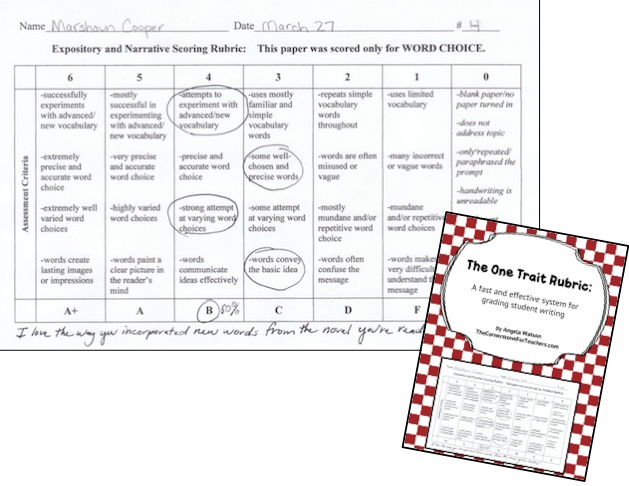I used to spend hours grading students essays and felt extremely frustrated by the subjectiveness of my system. It was very difficult to think about all six traits of effective writing–ideas/content, organization, voice, word choice, sentence fluency, and conventions–at one time while grading. I’d often get sidetracked by mistakes in one area, such as spelling or punctuation, and find myself tempted to score the paper lower than I should have because of those errors. Similarly, my students would find themselves too focused on one particular aspect as they were writing and would completely neglect the other traits.
The solution hit me one day in the middle of a modeling a narrative essay for my third graders: if we teach traits of effective writing individually, why not assess traits individually sometimes, too? Not every piece of writing needs a full assessment, and one trait rubrics make it easy for teachers to give meaningful feedback quickly without spending hours grading essays.
Using a straightforward rubric with only 3 or 4 criteria makes it clear to students and parents why an assignment earned the grade it did. It also prevents the teacher from downgrading a paper by weighting one aspect of good writing too heavily. Concentrating on only one trait makes it easier for the teacher to fairly assess a student’s skills in a particular trait.
The system is beneficial for students, too. It can be overwhelming (especially for younger children, reluctant writers, and English language learners) to try to concentrate on all aspects of great writing at one time. Knowing that they’ll only be assessed on a single trait helps students narrows their focus and makes the task more manageable.
I searched everywhere online for solid, kid-friendly one trait rubrics and wasn’t able to find what I needed. So, I created my own! I used the rubrics for years with my students and found that teaching AND assessing writing was greatly simplified. A few months ago, I polished them up a bit in order to make the rubrics available on TeachersPayTeachers.
The final version I created includes 6 rubrics, one for each of the 6 traits of effective writing: ideas/content, organization, voice, word choice, sentence fluency, and conventions. I chose these traits because they’re a well-known way to organize writing instruction. However, you can use these rubrics with ANY writing curriculum and methodology, including Lucy Calkin’s Writer’s Workshop, Write Steps, Step Up to Writing, etc.
I like to kids staple the rubric to the front of their paper before turning it in and then self-assess. They can evaluate their own writing by circling how they think they scored in pencil, and the teacher can score on the same rubric with a pen. Both teacher and student can write comments at the bottom of the rubric or on the back.
The writing rubrics were designed for use in grades 3-12. That’s a pretty broad grade range, I know! But during the two years I was a Literacy Coach, I used these rubrics with students from age seven through fifteen in schools across New York City, and never met a group of kids (or teachers) that didn’t find the rubrics useful. There is some sophisticated vocabulary in the rubrics, but I’ve seen kids as young as age 7 use them after modeling and practice.
Even if you don’t purchase the one trait rubrics that I created, I still encourage you to try teaching and assessing one trait at a time. I have seen the evidence–one trait rubrics will help you refine your writing instruction, help students better understand characteristics of effective writing and how their work is assessed, and simplify your scoring process.

Angela Watson
Founder and Writer
Discussion
Leave a Reply
OR

Join our
community
of educators
If you are a teacher who is interested in contributing to the Truth for Teachers website, please click here for more information.


















Good morning, Angela , how are you doing? I like your website. I am writing to ask permission to use the rubric and my blog. In addition, can you please share the website.
Thank You
Ella
Hi, Ella, can you clarify what you mean by permission to use the rubric? You can certainly link to this post or link to the product in TeachersPayTeachers.